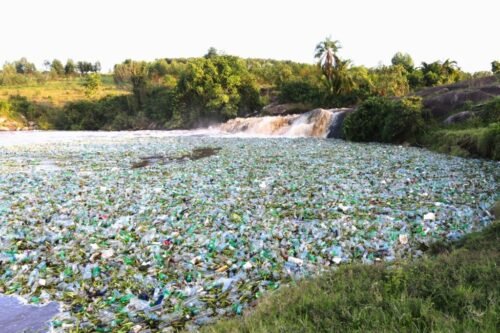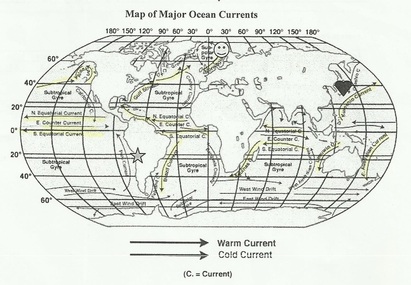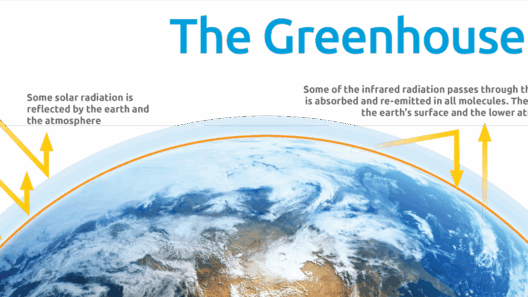The greenhouse effect is an intricate mechanism that plays a critical role in maintaining the Earth’s habitability. While it is often criticized for its association with climate change, the energy that fuels this phenomenon merits exploration. Understanding the origins of this energy unveils the delicate balance of our planet’s ecosystems and the intricate interplay between solar energy and terrestrial systems.
To appreciate the dynamics of the greenhouse effect, one must first delve into the principal source of energy—that is, the sun. The sun emits an immense amount of energy in the form of electromagnetic radiation. This energy travels across the vast expanse of space and reaches Earth, where it is absorbed by various surfaces, including oceans, forests, and urban environments. When sunlight strikes the Earth, nearly half of it is absorbed, warming the surface of the planet. The aesthetic beauty of sunlit landscapes is not merely in their appearance; it is the very core of life-sustaining energy.
Once the Earth absorbs solar radiation, it does not keep it indefinitely. Instead, it re-emits this energy as infrared radiation—a process essential to the greenhouse effect. This transformation of energy is fundamental to understanding how heat is trapped in the Earth’s atmosphere.
The intricate layers of our atmosphere contain various gases, including carbon dioxide (CO2), methane (CH4), and nitrous oxide (N2O). These gases serve as a thermal blanket, capturing some of the outgoing infrared radiation and re-radiating it back toward Earth. This process creates a warm, stable environment, making our planet conducive to life. However, as human activities have significantly increased the concentration of these gases, the thermal blanket has become thicker, resulting in an enhanced greenhouse effect. A deeper investigation into this warming phenomenon reveals not only climatic concerns but also the ethical implications of our environmental impact.
Contributions to the Greenhouse Gas Emission: The Human Footprint
Human activities have drastically altered the natural balance of greenhouse gases in the atmosphere. Industrialization, deforestation, and agricultural practices all contribute to elevated emissions. Industrial processes release CO2 from burning fossil fuels for energy production, while land-use changes such as deforestation decrease the number of trees able to absorb CO2. This two-pronged effect intensifies the greenhouse effect, and this increase fuels long-term temperature rise.
Additionally, digestive processes from livestock produce substantial amounts of methane—an even more potent greenhouse gas than carbon dioxide. The utilization of synthetic fertilizers in agriculture also releases nitrous oxide, further contributing to atmospheric warming. These anthropogenic activities are not only reshaping the environment but are also endangering the delicate balance of ecosystems around the globe.
The underlying dilemma is that while the greenhouse effect is a natural and essential phenomenon, its anthropogenic enhancement is jeopardizing climate stability. This revelation of our hand in altering energy dynamics invites reflection about stewardship: how should humanity engage with the planet to sustain its delicate thermal equilibrium?
The Connection Between Greenhouse Gases and Energy Transformation
To understand the broader implications of the greenhouse effect, one must consider how energy transformations occur within the biosphere. The absorption of solar energy by plants—a process known as photosynthesis—illustrates a critical relationship between solar energy and living organisms. Plants convert sunlight into chemical energy, storing it in the form of glucose. This stored energy forms the foundation of food chains, supporting a myriad of organisms, including humans.
As the energy captured by plant life is transferred through the trophic levels, it unveils the vibrant interconnectedness of Earth’s ecosystems. Each organism, from the smallest microbe to the largest mammals, plays a vital role in utilizing and redistributing this energy. Biodiversity enriches this energy web, leading to enhanced resilience against external stressors, including climatic changes.
However, the growing concentration of greenhouse gases threatens this intricate system. Altered precipitation patterns, increased temperatures, and extreme weather events disrupt the delicate balance, forcing organisms to adapt at unsustainable rates. The aesthetic wonder of nature, from sprawling forests to rippling oceans, is not merely for human enjoyment but is crucial in absorbing and redistributing energy on the planet.
Contemplating Solutions: Innovating for a Sustainable Future
Recognizing the origins of energy within the greenhouse effect calls for innovative thinking and proactive measures. Solutions range from promoting renewable energy sources to reimagining agricultural practices. By investing in solar, wind, and hydroelectric energy, humanity can reduce its dependency on fossil fuels—thereby diminishing greenhouse gas emissions. Reforestation initiatives and sustainable land management practices are equally vital, as they not only absorb CO2 effectively but also enhance biodiversity.
Moreover, societal shifts toward sustainable consumption and waste reduction can contribute significantly to emission reductions. Every choice, from the products we purchase to our methods of transport, has implications for energy dynamics within the atmosphere. Education plays a crucial role in fostering awareness, allowing individuals to become informed stewards of the planet who advocate for policy changes and community-driven initiatives.
Ultimately, the energy underlying the greenhouse effect is not merely a scientific phenomenon; it is a call to action. It beckons humanity to explore, innovate, and collaborate in ensuring that the Earth remains a hospitable refuge for all forms of life. The ongoing narrative of our planet’s health is intertwined with the stewardship of its energy balance. By tracing the origins of this energy and recognizing its significance, society can work toward a sustainable future that honors both the beauty and the fragility of the Earth.








